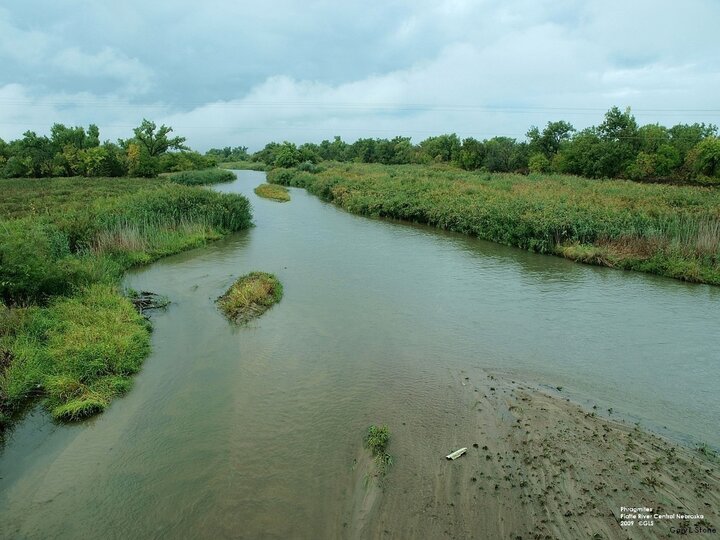Early Detection and Rapid Response (EDRR) is a concept to identify potentially invasive species prior to or just as the establishment of the invasive is taking place. An Integrated Pest Management plan (IPM) can be developed to manage, contain and eradicate the invasive species before it can spread further. This will avoid costly, long-term control efforts.
Phragmites / Common Reed
a.k.a. – Common reed, giant reed, canegrass
Scientific name: Phragmites australis subsp. australis - non-native
Phragmites australis subsp. americanus - native
Family: Poaceae (Grass family)
Native vs. Non-native
Both sub-species can be found in Nebraska. The table below will indicate the characteristic differences between the two. Native Phragmites australis subsp. americanus is a beneficial wetland species.
|
Native common reed- americanus |
Leaf sheaths not or loosely attached to culms |
Stem texture is smooth & shiny |
Over all plant color is light yellow green |
Small round black spots visible on stem |
Low stem density |
|
Non-native common reed - australis |
Leaf sheaths attached to culms |
Stem texture is rough & dull |
Overall plant color is darker blue green |
No small round black spots on stem |
High stem density |
Description, Habitat & Impacts
Origin: Native and Europe. European / non-native species was introduced into the United States along the east coast in the early 19th century. It wasn’t until 2002 that genetic testing determined that there was a non-native species. Today, non-native phragmites can be found over much of North America.
Since the native sub-species is not an invasive plant, the remainder of this article will focus on the non-native sub-species australis.
Phragmites australis subsp. Australis greatest impact is on water ways, riparian areas and rights of way. It is a perennial grass that reproduces by seed, stolons and rhizomes. Root segments can also produce new plants. Rhizomes can grow up to 30 feet in length each year. The vigorous and extensive root system of this plant can produce up to 200 stems per square yard. Stems can be 6 to 16 feet tall with 80 percent of the biomass below ground in the root structure. Roots can be up to nine feet deep. Flowering can produce up to 2,000 seeds from each large plume-like inflorescence in July.
Non-native australis is very aggressive and forms monocultures which outcompetes native vegetation. This in turn reduces native plant diversity and ecology with changes in related animal, fish and insect habitat. Wetland hydrology is also affected by increasing sedimentation rates. Recreational activities are also impeded by blocking access to water ways and channeling water. Dry growth is a potential fire hazard.

Management
Phragmites australis subsp. Australis is a designated noxious weed under the Nebraska Department of Agriculture’s Noxious Weed Program. Utilizing an Integrated Pest Management (IPM) plan with long-term goals should be implemented to control this plant. Using more than one management option is the key to success.
Prevention, proper identification and early detection are the most effective measures to manage the plant. There are no recommended biological control methods at this time.
Mowing is one method to manage non-native phragmites but it should be done several times during the growing season to be effective. Mowing alone will not provide control.
Both intensive grazing or prescribed burning alone will not control non-native phragmites. Both will remove top vegetative growth, but both should be used with other management measures.
There are two chemical treatment options available to manage Phragmites australis subsp. Australis that show the best promise for control. Herbicide products containing glyphosate and imazapyr labeled for aquatic site use, alone, or in combination, have been effective. Spring chemical applications are made when plants are 2 to 3 feet tall. Fall chemical applications should be made 2 to 3 weeks prior to a killing frost. Monitor regrowth of surviving plants as repeated herbicide applications may be required. Be sure to select a product labeled for the site. Read, understand and follow all label instructions when using any pesticide.
Nebraska Extension Publications has a number of publications on noxious weed management and other invasive species. These publications and much more are found at http://extensionpubs.unl.edu/ . Search “common reed” or “invasive”.
References
Avers, B., et al, “A Guide to the Control & Management of Invasive Phragmites”, Michigan Department of Environmental Quality
Knezevic, S., et al, “Noxious Weeds of Nebraska Common Reed”, University of Nebraska, EC166, Lincoln, NE
Meyer, B., “Landowners Guide for Controlling Phragmites”, Lancaster Weed Control Authority, Lincoln, NE
Stubbendieck, J., et al, “Weeds of the Great Plains”, Nebraska Department of Agriculture, Lincoln, NE, 2019
Tilley, D., & St John, L., “Common Reed”, USDA NRCS Plant Guide, Plant Materials Center, Aberdeen, ID
Interviews with the authors of BeefWatch newsletter articles become available throughout the month of publication and are accessible at https://go.unl.edu/podcast.

